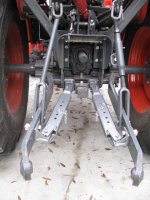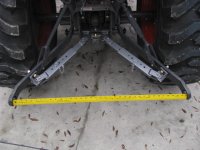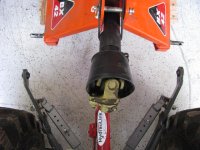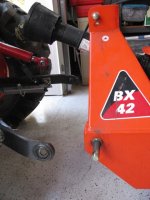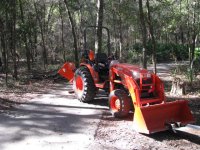I'm with you and the "trout" on this too. You can't get discouraged after only trying something one time, especially if no one has given you any instruction or hints. Farmers have been hooking and unhooking Cat I and Cat II stuff for decades without after market couplers and doing it parked on the dirt not a concrete floor using dollies. The early top links on Ford/Dearborn/Ferguson stuff were not even easily adjustable for variable length out in the field, just two pieces of flat stock bolted together.
When I back into an implement that's not on level ground (or the tractor's not on level ground!) always hook first to the pin on the implement that is lower to the ground. Then you can raise the position control a little; this will do two things, it will lower the other side so you can make the connection and also take some weight off the ground in case you have to shove the machine around a little. You can also use the leveling crank to help if you have one. Connect the top-link last. If it is too "long", again just raise the position control a little and it should fall into place. If the top-link is too "short" you can usually just drive forward a little and the implement will tip forward allowing the top link to be connected; or you can adjust the top link length if that is easier. When unhooking always disconnect the top link first. Again you can use the position control, move the tractor forward a little, or adjust the top link to take any tension off the link.
I've seen friends get discouraged the first few times but eventually they seem to get the hang of it. With the after-market adapters there's always the potential for more problems if you acquire additional used implements in the future or something that doesn't work right because the lower arms have been extended.

